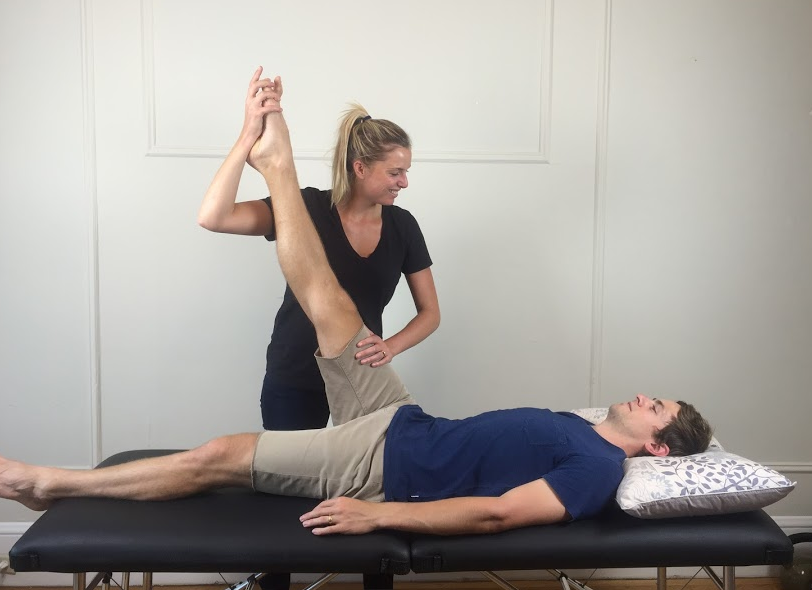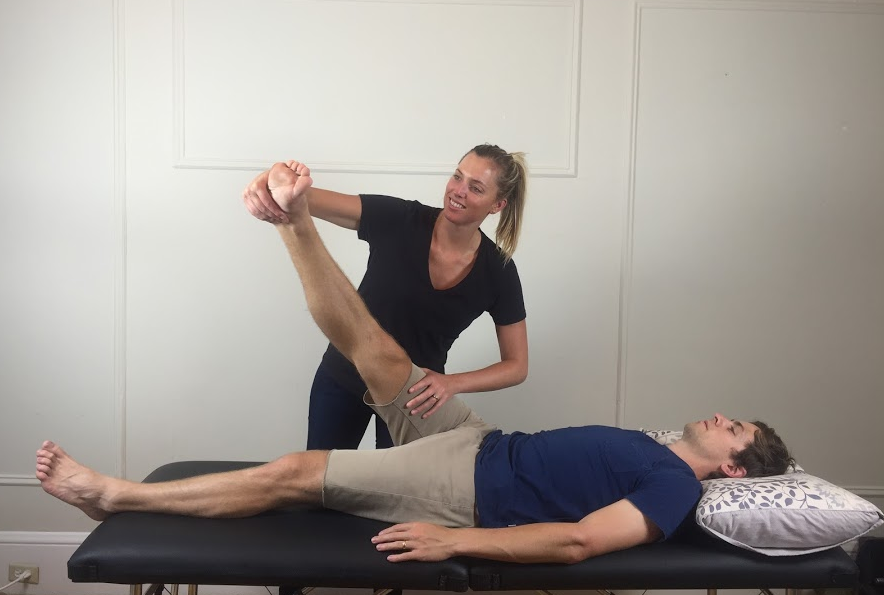Improving Hamstring Flexibility - part 2 Treatment
How to best manage ‘perceived hamstring tightness’.
The second part of this blog explores the treatment techniques available to us to improve hamstring tightness, and the research which compares these techniques.
The main point raised from the previous blog was that hamstring tightness is commonly a reflection of neural mechanosensitivity. With this view in mind, it can be hypothesised that exercises thought to target the neural mobility or the neurodynamics system would be better methods of treating ‘perceived hamstrings tightness’ (Mhatre, et al., 2013, p. 155).
Studies investigating treatments for perceived hamstring tightness.
One thing we know from clinical practice is that passive stretching works .... But the question is can we make our results even better?
Marshall, et al. (2011) investigated the effect of passive lower hamstring and gluteal stretching over a four week period; on muscle length, stiffness, stretch tolerance and strength, in young asymptomatic individuals. Their results refuted the premise that stretching leads to reduced muscle strength and they established that passive stretching 5 days a week for 4 weeks will result in a 30% reduction in muscle stiffness and 20% increase in muscle extensibility, without a change in stretch tolerance or strength.
The exercises used in this study included a supine hamstring stretch, a supine gluteal stretch, a seated gluteal stretch, and a deadlift/good morning hamstring stretch, with each exercise held for 30 seconds and repeated 3 times. This study looks solely at passive stretching. Similar studies which then compare passive stretching to/or in combination with neural mobility exercises demonstrate an even greater improvement in overall flexibility.
Neurodynamic sciatic slider technique performed by the therapist (Castellote-Caballero, Y., Valenza, M. C., Puentedura, L., Fernandez-de-las-Penas, C., & Albuquerque-Sendin, F., 2013).
The following studies have a stronger neurodynamic focus.
Study #1:
Castellote-Caballero, Valenza, Puentedura, Fernandez-de-las-Penas, and Albuquerque-Sendin (2013) conducted a pilot study with 120 patients suffering from bilateral short hamstring syndrome. Their aim was to identify the immediate effect of neurodynamic hamstring sliders compared to static hamstring stretching on hamstring flexibility. Neurodynamic sliders were performed for 90 seconds on each leg, which is a dosage consistent with many other studies. This included a passive hip/knee/ankle slider in supine. Their results showed that while static hamstring stretching resulted in a 5 degree increase in hamstring flexibility, neurodynamic sliding techniques produced a 10 degree increases (statistically significant). The authors concluded that neurodynamic sliding techniques are more effective in the short term than static hamstring stretching.
Study #2:
Castellote-Caballero et al. (2013) conducted a pilot study (a second one) which evaluated the immediate effect of neurodynamic sliding on hamstring flexibility in healthy soccer players. They compared the effect of 5 x 60 seconds of an active slump slider to a control group, and measured the change in range during the passive SLR test. The results revealed that neural sliders produced on average a 8 degree improvement in available range of the SLR test, while no improvement was noted in the control group.
Study #3:
Mhatre, et al. (2013) compared Mulligan's bent leg raise and two leg rotation (neural mobility) versus passive/active hamstring stretches in 56 young female physiotherapy students who reported perceived hamstring tightness. They assessed changes in hamstring tightness in the Active Knee Extension Test and Slump Test. The treatment group received 3 x 30 seconds of the Mulligans bent leg raise and actively performed a double leg lumbar rotation 3 x 30 seconds with their feet lifted off the floor. The control group received 3 x 30 seconds of passive hip flexion strength with knee extension and actively performed a static hamstring stretch 3 x 30 seconds. At baseline the average knee flexion angle on the active knee extension test was 34 degrees for both groups. Both groups demonstrated a significant reduction in knee flexion angle, and although the treatment group has better results compared to the control group, the difference between groups was not statistically significant. These outcomes were taken immediately post treatment and no long term comparison was made. The authors concluded that exercises which target neural mobility tend to be more effective in reducing perceived hamstring tightness.
These are three studies that support neurodynamic-centric hamstring exercises. The next question is what exercises are they referring to?
Neurodynamic hamstring mobility techniques.
Neurodynamic opening techniques
Neurodynamic techniques can involve numerous variations and changes in position. The most important factor is to determine a suitable starting position for the specific patient (supine, side lying or sitting), determine if a sliding or tension dysfunction is the main focus for treatment and then decide on the degree of resistance applied to each technique.
Shacklock describes neurodynamic treatment for restricted sciatic nerve mobility in the hamstring in the form of a sliding dysfunction and tension dysfunction. (The research above refers specifically to sliding dysfunction).
Proximal and distal sliding dysfunction.
- Level 1. This involves a passive straight leg raise with ankle plantar flexion during hip flexion, and ankle dorsiflexion during the lowering phase. (Image 1 & 2)
- Level 2. In long sitting (with a pillow under the knee) the patient performs the distal slider with ipsilateral trunk lateral flexion and ankle dorsiflexion. The proximal slider involves contralateral trunk lateral flexion and ankle plantarflexion. (Image 3 & 4)
Tension dysfunction (use cautiously).
- Level 1. During the straight leg raise movement apply gentle ankle dorsiflexion and hip internal rotation. (Image 5)
- Level 2. In long sitting (as above for sliding technique) the patient performs gentle knee extension. Alternatively in long sitting a tension treatment can be used by using cervical flexion, knee extension and ankle dorsiflexion. (Image 6)
Slump Slider / Two-ended slider
The two-ended slider (AKA slump slider) is categorised as a lumbar spine treatment, which I commonly use in clinical practice for restricted hamstring mobility/ straight leg raise dysfunction.
The slump slider can be performed in side lying (painful side uppermost) or in sitting and involves combined knee extension/cervical extension and knee flexion/cervical flexion. Shacklock describes the treatment being performed with both legs moving simultaneously, but it can also be performed unilaterally or by alternating legs. It is a fantastic home exercise program which replicates treatment and allows for patients to independently work on their restricted mobility. For further description refer to Shacklock (2005, p. 202).
Mulligan's Bent Leg Raise
The Mulligan's Bent leg raise technique is a painless muscle energy technique which involves isometric contraction of the posterior thigh muscles. Begin in the position seen here, with the affected knee on the therapist's shoulder and take the leg as far into hip flexion as possible without pain. The patient is asked to pull their heel down into the therapist's shoulder to create an isometric contraction and following relaxation, the hip is moved further into flexion.
The post isometric contraction relaxation is proposed to improve connective tissue extensibility, while moving the hip into flexion creates a caudal glide on neural structures and nerve trunks, helping to offload neural structures and disperse neural oedema.
If there is pain move the hip into abduction and reassess. If this does not remove the pain, abandon the technique. Mulligan stresses the importance of the the BLR technique being painless.
You may also wish to add a small amount of traction during the sustained stretch. After three repetitions lower the leg and reassess the SLR test. (Mhatre, et al., 2013, Mulligan, 2010)
Mulligan's two Leg rotation
Mulligan's two leg rotation technique (self treatment) again is performed as a painless treatment for patients with a restricted straight leg raise. It can be performed by the therapist or independently by the patient. Similar to the BLR technique, this is used for patients without pain below the knee.
Mulligan also refers to the straight leg raise with compression/traction as a treatment for a restricted straight leg raise with symptoms above the knee. For further details refer to his text Manual therapy, NAGS, SNAGS, MWMS, etc. The above two techniques were evaluated in the research commented on above.
Static hamstring stretches
There are many variations of a static hamstring stretch which can be performed by the therapist or independently by the patients.
In the available research static stretches were held for 30 seconds and repeated 3 times for a single treatment and repeated up to 5 days a week.
How can this be applied to clinical practice?
Assessment
Neurodynamic assessments such as the straight leg raise and slump test should be an essential part of assessment and reassessment.
A point to remember is that the SLR test has been measured at the point which P1 occurs. Shacklock emphasises that for a SLR test to be positive, the test should reproduce the patients symptoms. Few studies comment on the range at which P1 was felt and the exact location/description of the symptoms. Being guided by the work of Maitland, Shacklock and Butler, it is import to make the tests reproducible and to ask “Is that your pain? ”, “Where do you feel that?” and determine what happens to the symptoms with further structural differentiation. There is no mention in the research where P1 was felt on these patients.
Treatment
Overall it can be concluded that exercises which target neural mobility are more effective in reducing perceived hamstring tightness. Based on this evidence we may need to revise our training programs and home-based exercise programs to target neural tissue mobility more than muscle extensibility.
Limitations in the research.
One major flaw in the available research is that all subjects are healthy and asymptomatic. This research provides clinicians with the treatment effect these techniques have on healthy individuals. There is little evidence to show the effect on those suffering from injury and the long term effect of such techniques. Therefore it is difficult to speculate how long exercises should be continued with long term to correct the asymmetry that reduced ‘hamstring length’ has on a particular condition.
And finally, high quality studies are lacking and the available studies are both of lower quality and investigate only the immediate effect of the exercises. Many studies use a generic dosage of 3 x 30 seconds for treatments and there is no evidence on dosages. Authors such as Butler and Shacklock provide further information and guidance regarding dosages of neurodynamic techniques.
Sian
References
Butler, D. S. (2005). The neurodynamic techniques: a definitive guide from the Noigroup team: Noi Group.
Castellote-Caballero, Y., Valenza, M. C., Martín-Martín, L., Cabrera-Martos, I., Puentedura, E. J., & Fernández-de-las-Peñas, C. (2013). Effects of a neurodynamic sliding technique on hamstring flexibility in healthy male soccer players. A pilot study. Physical Therapy in Sport, 14(3), 156-162.
Castellote-Caballero, Y., Valenza, M. C., Puentedura, L., Fernandez-de-las-Penas, C., & Albuquerque-Sendin, F. (2013). Immediate effects of neurodynamic versus muscle stretching on hamstring flexibility in subjects with short hamstring syndrome.
Cleland, J. (2005). Orthopaedic clinical examination: an evidence-‐based approach for physical therapists: WB Saunders Co.
Hengeveld, E., & Banks, K. (2005). Maitland's peripheral manipulation: Elsevier/Butterworth Heinemann.
Marshall, P. W. M., Cashman, A., & Cheema, B. S. (2011). A randomized controlled trial for the effect of passive stretching on measures of hamstring extensibility, passive stiffness, strength, and stretch tolerance. Journal of Science and Medicine in Sport, 14(6), 535-540.
Mhatre, B. S., Singh, Y. L., Tembhekar, J. Y., & Mehta, A. (2013). Which is the better method to improve “perceived hamstrings tightness”–Exercises targeting neural tissue mobility or exercises targeting hamstrings muscle extensibility? International Journal of Osteopathic Medicine, 16(3), 153-162.
Mulligan, B. R. (2010). Manual Therapy:" nags"," snags"," mwms" Etc. Optp.
Shacklock, M. O. (2005). Clinical neurodynamics: a new system of musculoskeletal treatment: Elsevier Health Sciences.
















